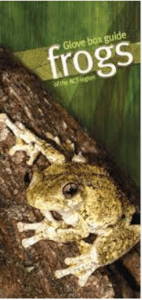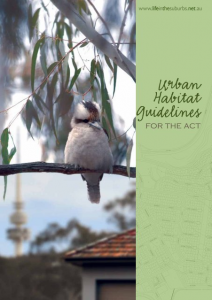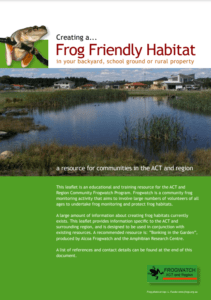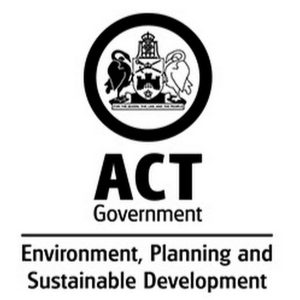Click for more Frog links
Here you can find all sorts of resources- keep scrolling!!
FrogCensus reports: 2023, 2022, 2021, 2020, 2019, 2018, 2017, 2016, 2015, 2014, 2013, 2012, 2011, 2010, 2009, 2008, 2007, 2006, 2005, 2004, 2003
Frogwatch at the Short Film Festival– Doco called URBAN FROGS done by Liana Fowler (a high-school student)
.  (all photos above courtesy of Peter Ormay)
(all photos above courtesy of Peter Ormay)
General information
Frogs of the ACT Region – Poster
 Our poster highlights many of the frog species most commonly found in the ACT and region, as well as a couple of rare species. It includes a photograph of each, and descriptions of appearance, calls and habitat.
Our poster highlights many of the frog species most commonly found in the ACT and region, as well as a couple of rare species. It includes a photograph of each, and descriptions of appearance, calls and habitat.
You can download a pdf of the poster here, or, if we have any left, you are welcome to pick up a copy at our office. Please contact frogwatch@ginninderralandcare.org.au to find out.
Glove box guide to Frogs of the ACT Region
The Molonglo Catchment Group has published a field guide to assist in the identification of selected frogs of the ACT and surrounding areas.
 The guide has been produced with the support of Forde Developments and with the cooperation of Frogwatch ACT.
The guide has been produced with the support of Forde Developments and with the cooperation of Frogwatch ACT.
You can download a pdf of the guide here
Creating a Frog Friendly Habitat in the ACT Community.
A helpful resource for residents in the ACT and Region with advice to encourage frogs to your backyard, school ground or rural property. Includes a list of recommended local plants for your frog habitat.
What Frog Is That?
Taking a photo of a frog can be a very hard thing to do- it is much easier to take a recording of their call!! You can submit a short 20 sec recording to the Canberra Nature Map– online or by using their Naturmapr app- you will get feedback on which species you recorded, which is a great way to get more confident identifying them.
Another good way to get some help is the FrogID from the Australian Museum. You can submit frog calls from anywhere by using your phone. Simply download the app, create a log on and off you go!! 
Lost Frogs?
Every week a number of frogs are accidentally imported into the ACT through fruit and vegie transport. They are usually tropical species that cannot survive in Canberra’s climate, nor can they be returned to their home state due to fears of spreading disease. If you find one of these frogs, you can contact ACT Wildlife 0432 300 033. The awesome wildlife carer Dorothy and Martin will look after the frogs.
Never touch a unfamiliar looking or injured frogs, rather pick it up with a clean plastic bag, place it in a clean container (washed out with hot water —no detergents or other chemicals). Add some boiled and cooled water and a few crickets and keep them safe.
Frogwatch census
Find your FrogCensus resouces here
Related resources
Bonking in the garden. Bonking in the Garden is the Why, How, and What of frog-friendly gardening – the indispensable introduction to attracting frogs to your garden. It has been published by Frog Watch (Victoria) as a small booklet and is now available online for you to keep. Visit frogs.org.au to download this from the Frog Watch Victoria website.
Frogs in an Effluent Society. Published by the World Wildlife Fund. Comprehensive guide explaining how environmental contaminants affect frogs – what pollutants are out there and where they come from, what we do and don’t know, what you can do to help and where to go for further information. Visit the WWF website or download here.
 Urban Habitat Guidelines – Produced as part of the Life in the Suburbs initiative to enhance community understanding of Urban Biodiversity and its importance in the future sustainability of our city. The Guidelines provide a guide to understanding the importance of urban habitat, and include principles for managing urban habitat, steps to reduce human induced threats to urban biodiversity, and practical guidelines for developing habitat gardens and landscapes. The guidelines include many links to ACT specific information, educational resources and contacts. Go to the link here to download the guidelines
Urban Habitat Guidelines – Produced as part of the Life in the Suburbs initiative to enhance community understanding of Urban Biodiversity and its importance in the future sustainability of our city. The Guidelines provide a guide to understanding the importance of urban habitat, and include principles for managing urban habitat, steps to reduce human induced threats to urban biodiversity, and practical guidelines for developing habitat gardens and landscapes. The guidelines include many links to ACT specific information, educational resources and contacts. Go to the link here to download the guidelines
Other online resources
There are a number of great websites, with information about Australian frog species, habitat requirements and downloadable files of frog calls.
Frog Links
Amphibian Research Centre. A first stop for Australian frog enthusiasts, this site provides comprehensive and varied information on all aspects of Australian frogs. Includes links to: Project Corroboree, The Victorian Frog Group, The Frogs of Australia Database, the Melbourne Water Frog Census, Alcoa Frog Watch, The Lost Frogs’ Home … and much more!
Give us a ring (62783309) or send us an email (frogwatch@ginninderralandcare.org.au) for more information.
Interested in becoming a member??? Download the GCG Membership Application Form (348 kb), fill in the details and post it back to Frogwatch /Ginninderra Catchment Group, PO BOX 446, Holt ACT 2615. Membership is free and includes insurance cover during all GCG related volunteer activities.
The ACT and Region FrogWatch Program, including the annual FrogCensus, is kindly funded by the ACT Government.
We are also supported by the ACT Herpetological Association– a great bunch of people with a wealth of knowledge!!


 ad your copy of Creating Frog Habitat
ad your copy of Creating Frog Habitat.PNG)
